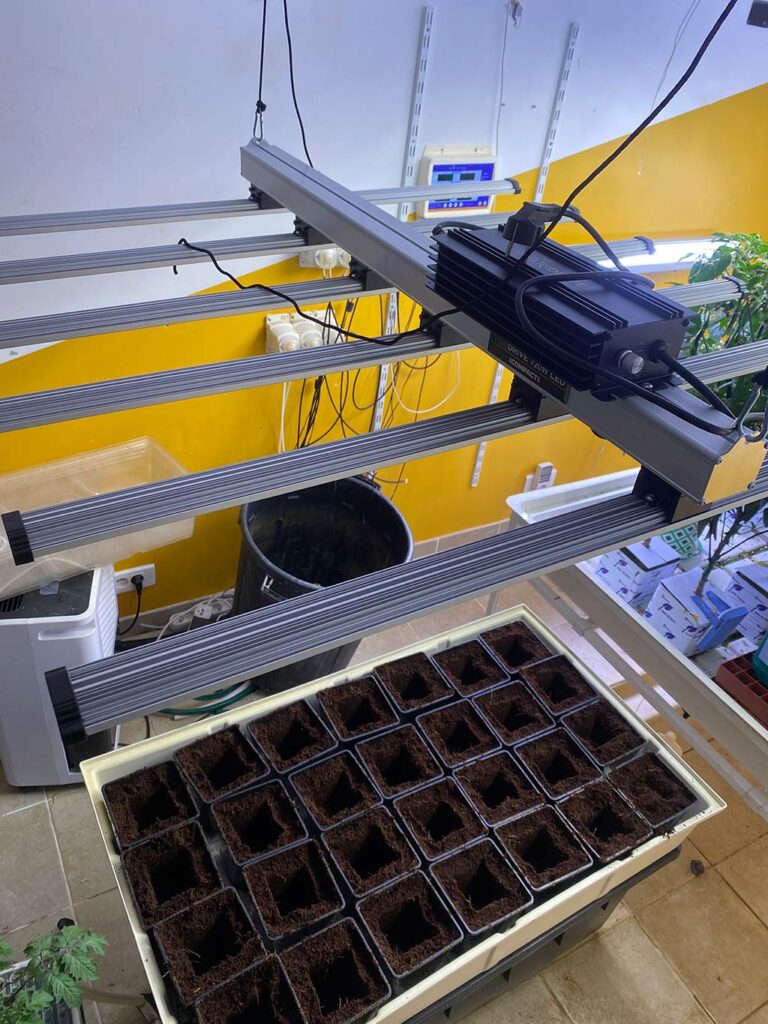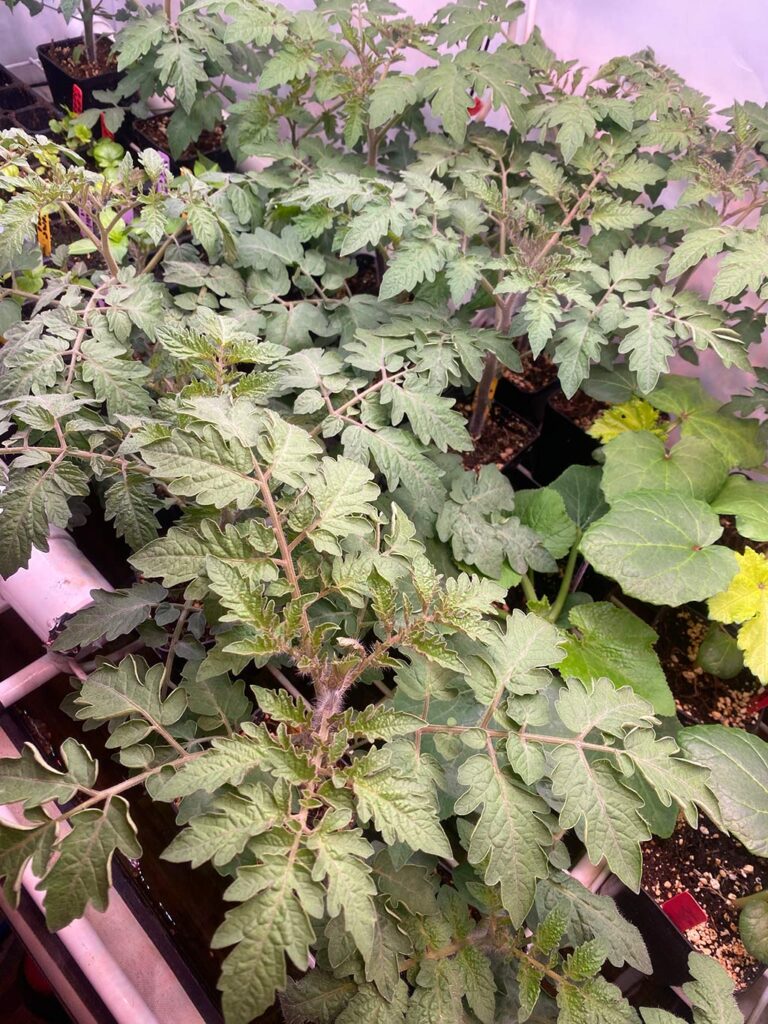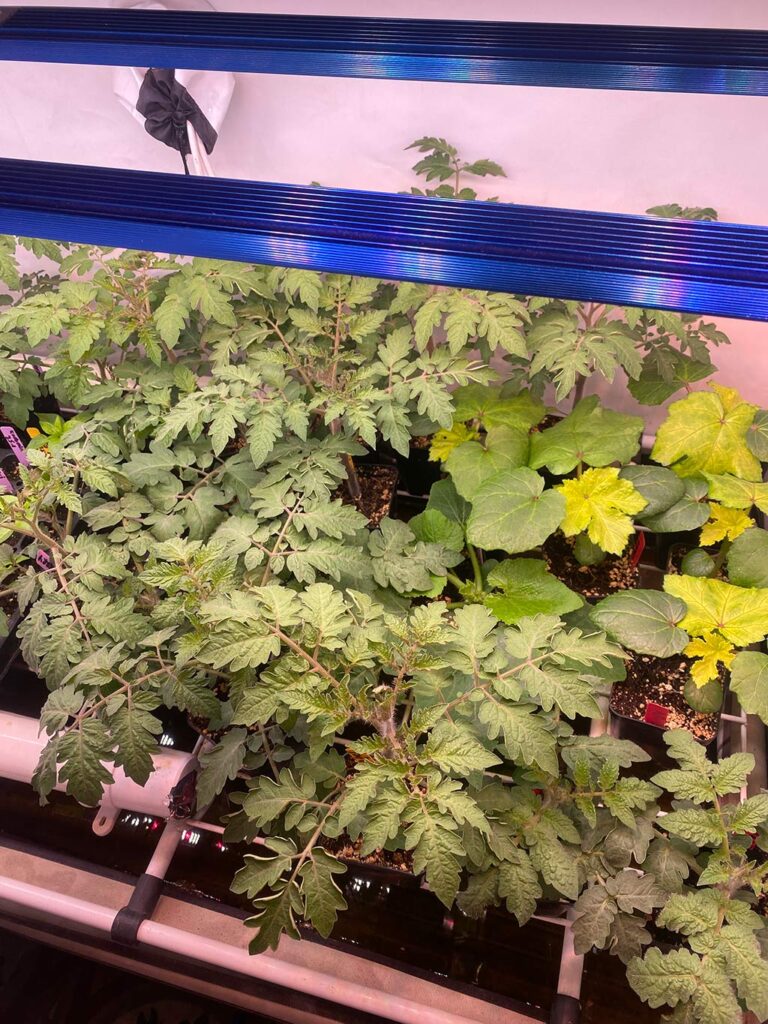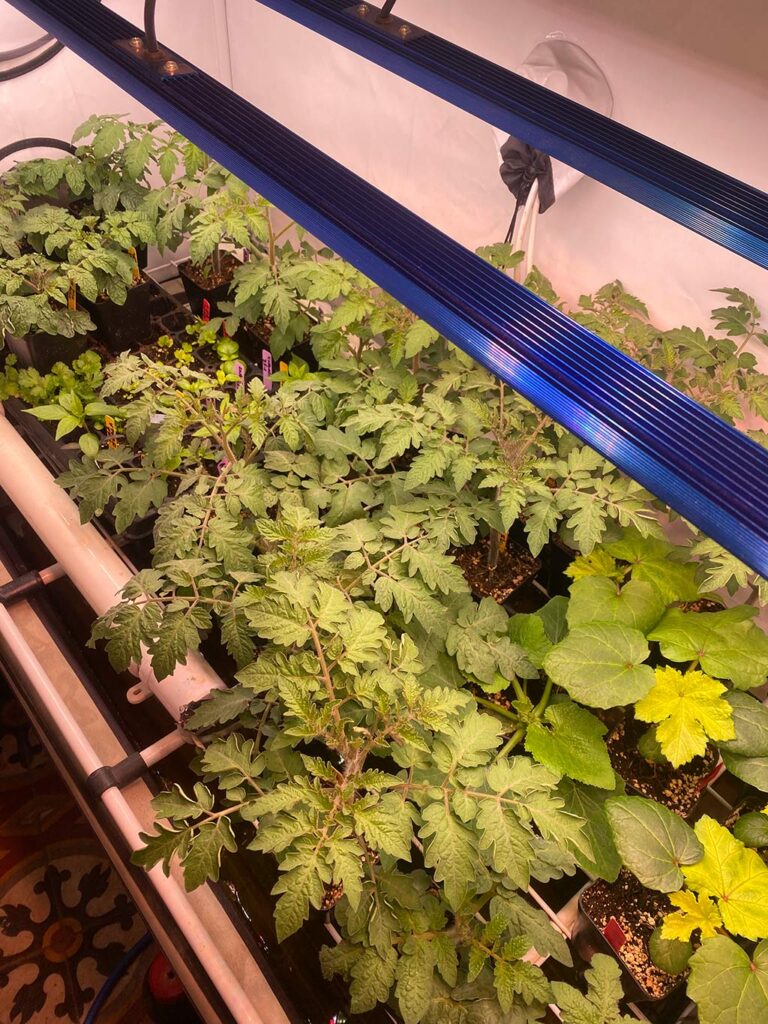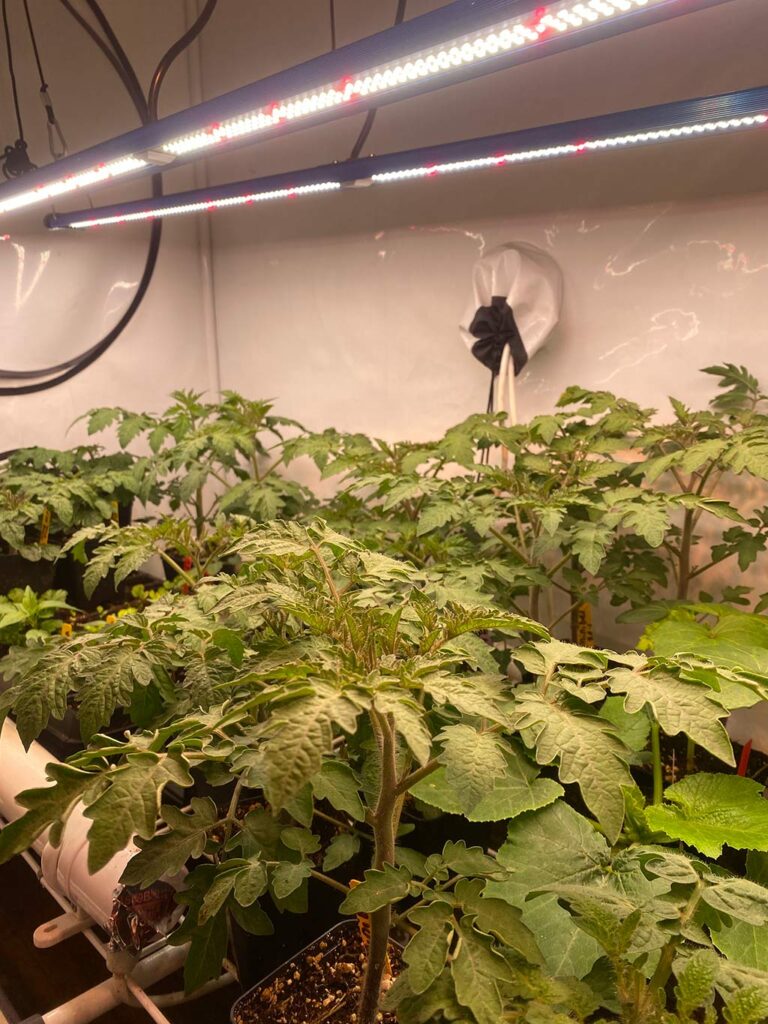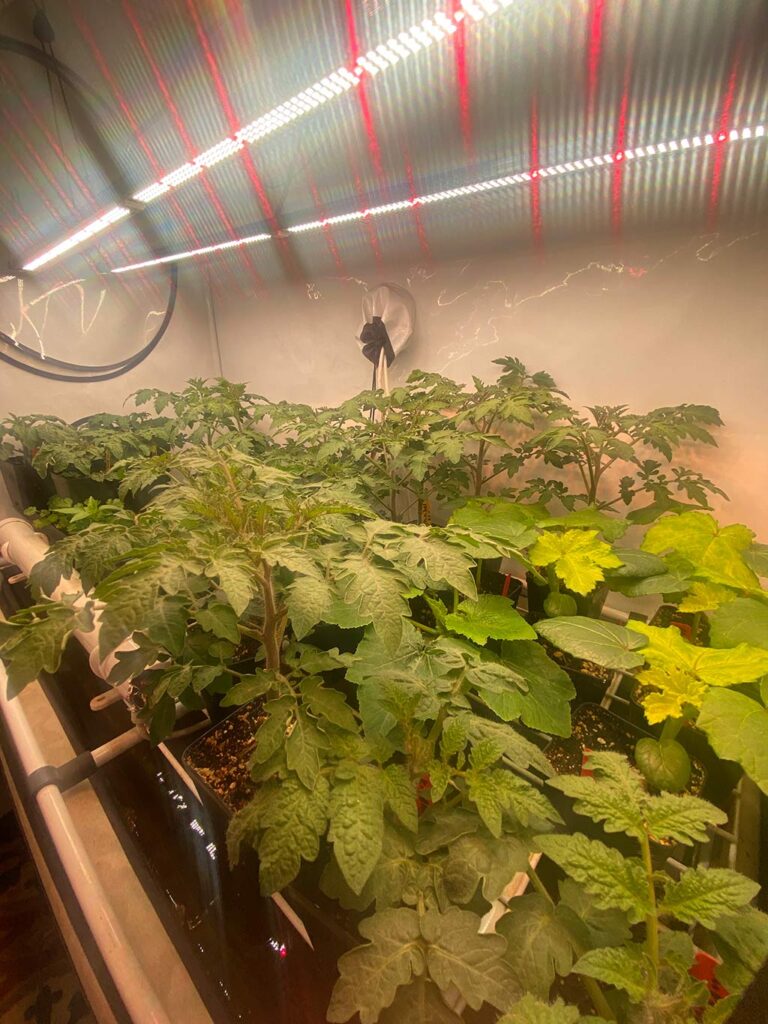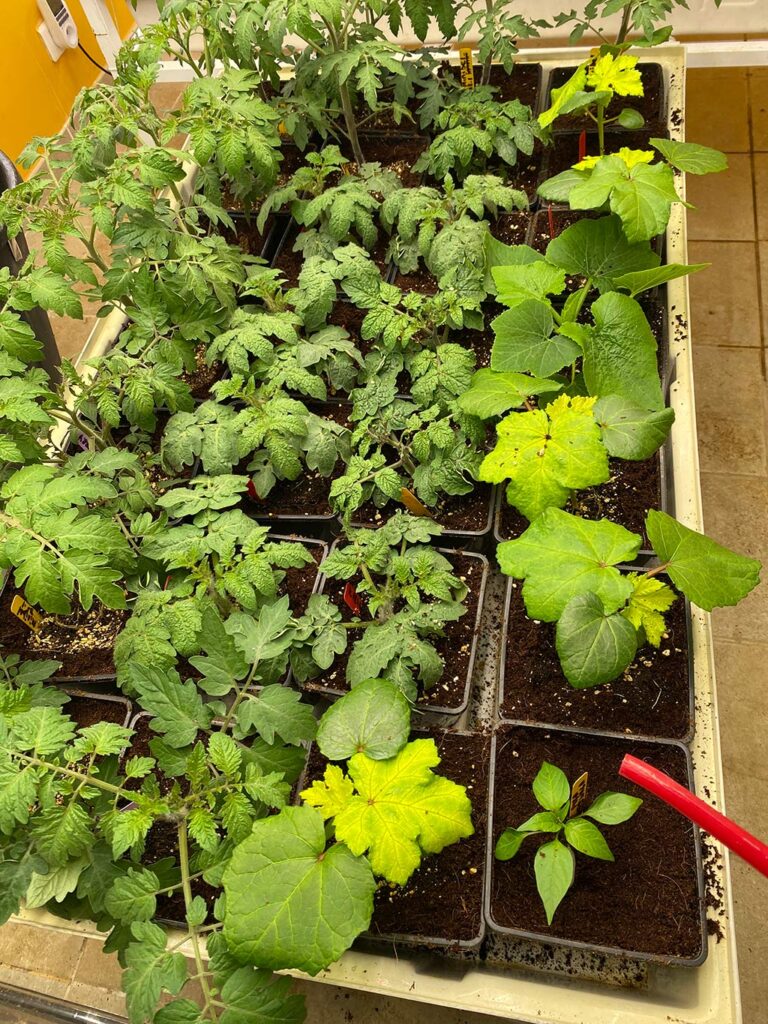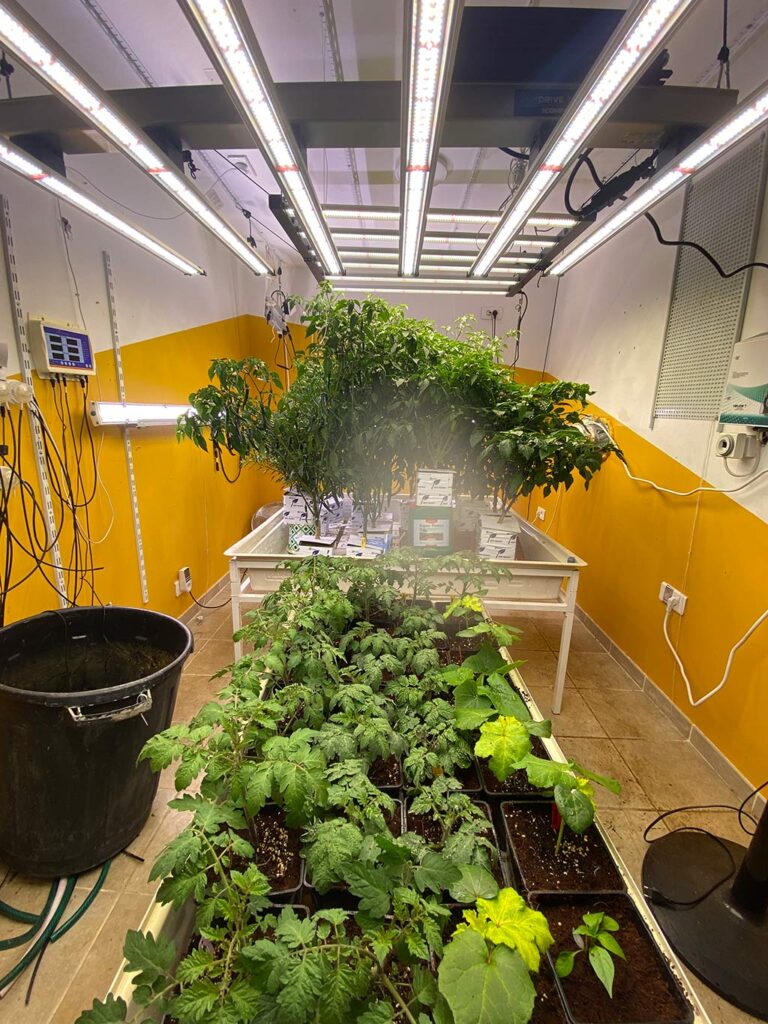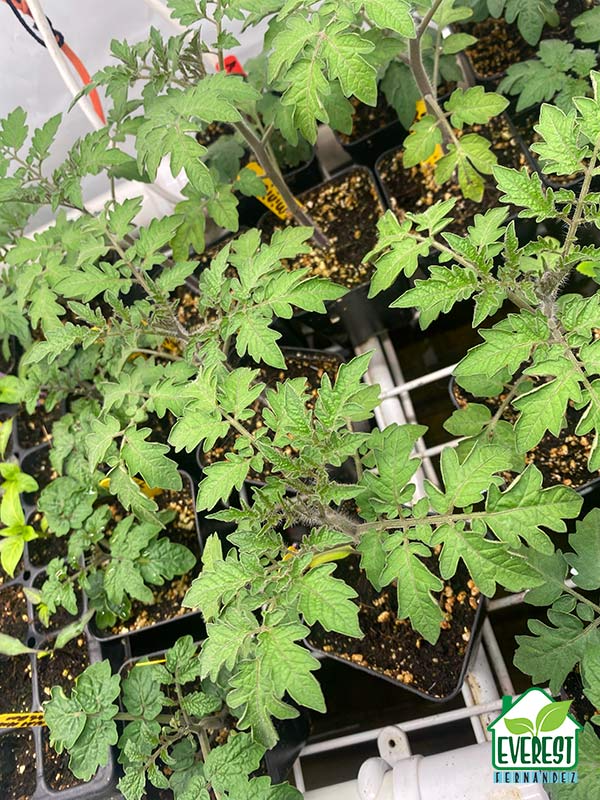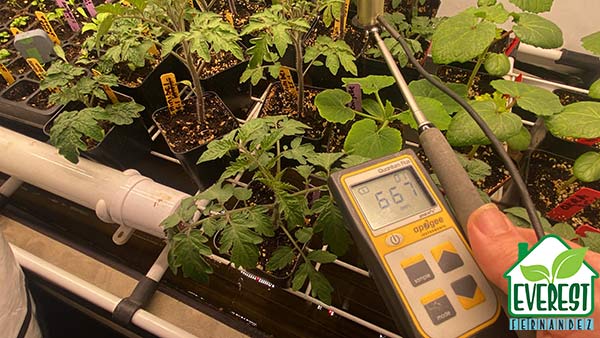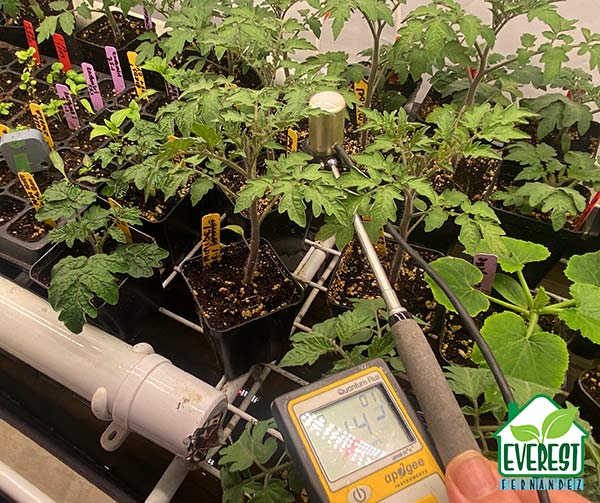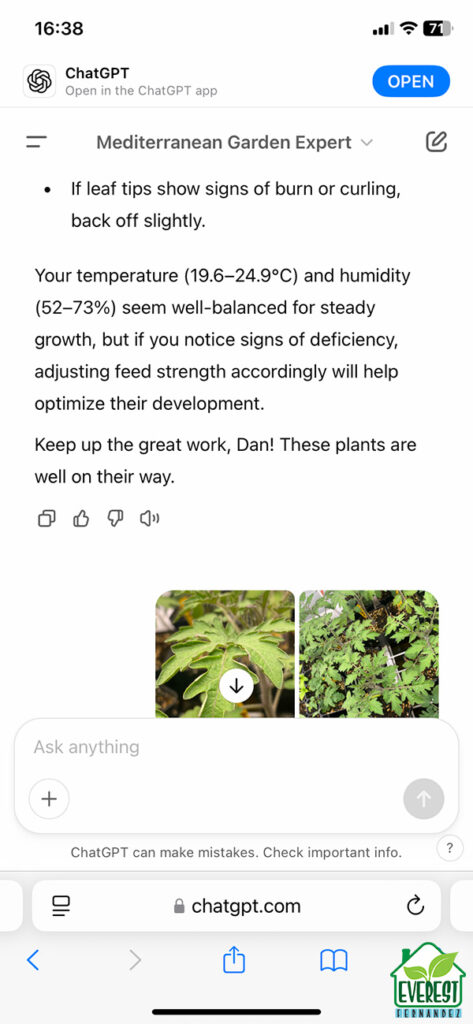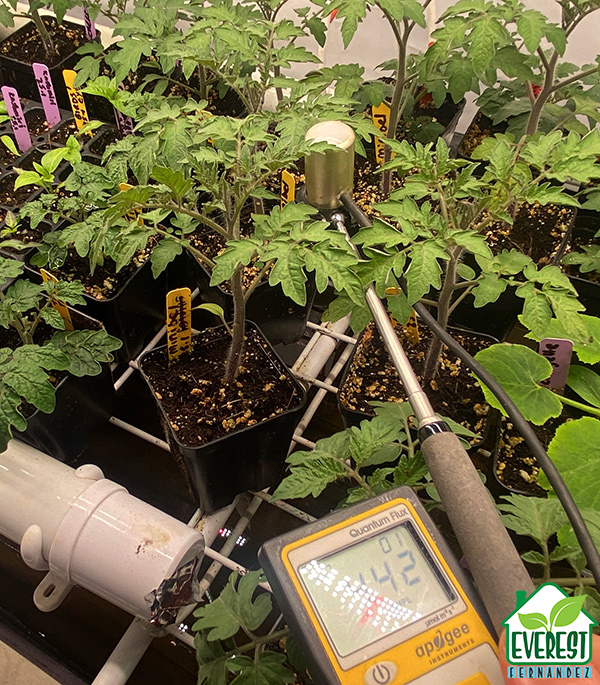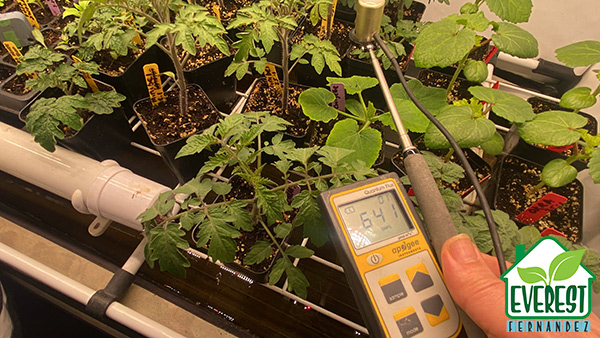Can ChatGPT be used to reliably diagnose plant issues and offer reliable remedies? Let’s find out.
Asking Artificial Intelligence To Evaluate My Tomato Seedlings
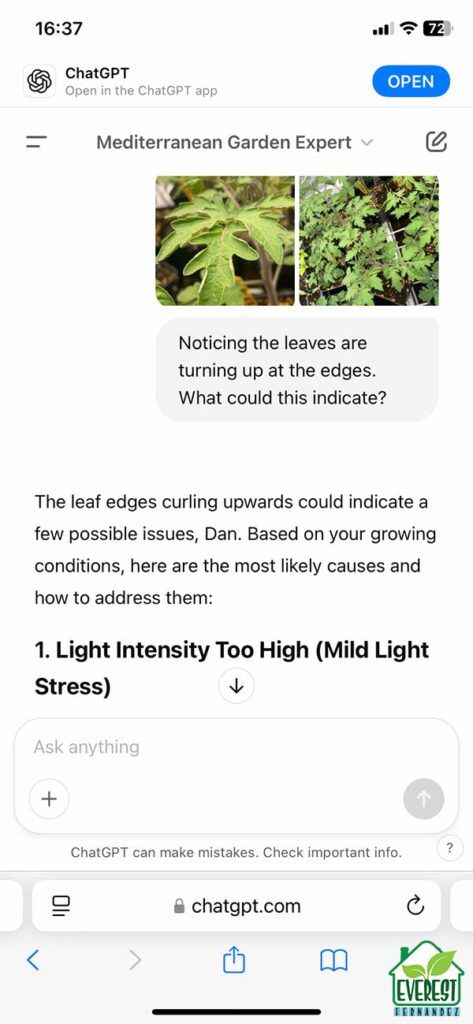
Note: Heads up. This isn’t going to be a “How To Use ChatGPT Tutorial”. If you’re completely new to ChatGPT and want to know how to get the most out of ChatGPT, then—ironically and appositely enough—the best place to find out is … ChatGPT!
Trust me. Simply go to www.chatgpt.com and enter the following prompt:
You are an expert in using ChatGPT. Your task is to introduce a keen gardener to ChatGPT’s features and functionality in a way that is engaging, practical, and inspiring. Provide a quick yet compelling overview, highlighting how ChatGPT can assist with gardening-related tasks such as plant care, garden planning, pest control, seasonal advice, and creative garden design. Showcase mind-blowing, unexpected ways ChatGPT can be a valuable tool for gardeners, sparking curiosity and excitement about its potential.
Whoops. Now you don’t need to read this blog post anymore. Just joking. Let’s get back to the issue at hand: Diagnosing Plant Problems with AI. After all, you want to find out about my personal experience with it, after all.
Short-ish answer: A little knowledge + ChatGPT can be a dangerous thing. If you have no idea what you’re doing with growing plants, ChatGPT could quickly lead you down some wrong paths! In the past it’s misdiagnosed oedema as spider mites and got me into a brief panic over nothing. However, don’t discount it just yet. These large language models are the worst they’re ever going to be right now. And there are ways to mitigate these risks and strategies to get the most out of ChatGPT so that it becomes a truly useful gardening companion.
Longer answer: A little domain knowledge is really helpful, so that you are more inclined to use ChatGPT as a collaborative assistant, rather than an infallible gardening guru. In other words, it really helps if you already know a little about how to read plants and have some ability to spot a potential problem early on—but I appreciate that this is a key skill that gardeners refine over years of experience. After all, it doesn’t take a pHD in Plant Science to suspect something’s up when a seedling is keeling over and crispy!
Remember—ChatGPT is a multi-modal large language model. Say what? That’s just AI jargon to express the fact that you can send ChatGPT photos as well as words. Use this to your advantage by taking lots of snaps of your plants on your smartphone.
If you’re a new grower then consider sending ChatGPT a few photos as part of your daily plant maintenance regime, whether you “see” a problem or not, rather than waiting for something obvious to trigger you.
Key Photos to send ChatGPT:
- New growth (growth tips, emerging leaves, taken from above)
- Established growth (mid-section and lower leaves)
- Whole plant shots
- Buds, flowers, fruits (if applicable)
- Show distance between grow lights and canopy
- Show containers and growing medium
Back To My Tomato Seedlings…
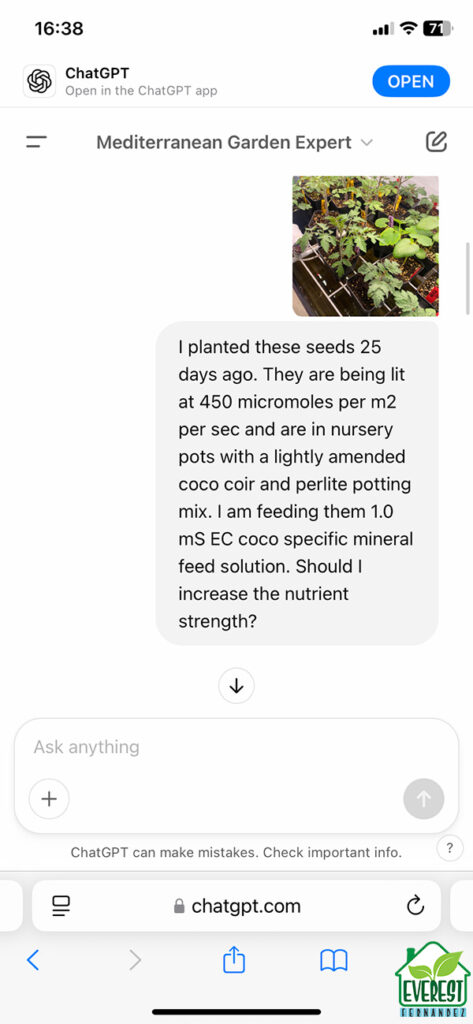
I’m currently growing tomato seedlings (Black Cherry and two cold-resistant dwarf varieties—Minibel, Tiny Tim—plus another Austrian cold-resistant variety) in my HOMEbox Vista grow tent (formerly known as the Clonebox.) It has a floor space measuring just 125 x 65 cm but is illuminated by 2 x 100W Full Spectrum “Daylight LED” bars by Maxibright.
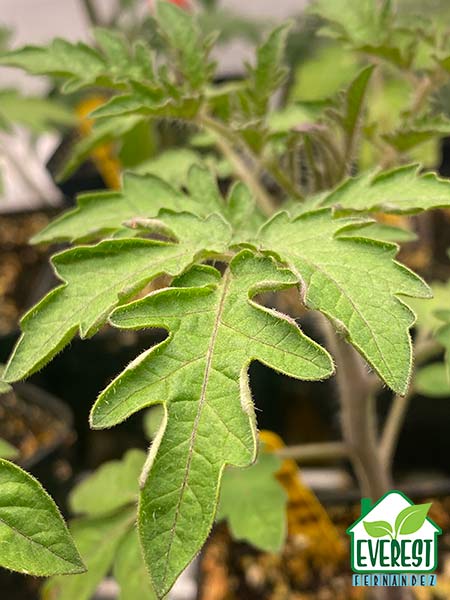
As the seedlings pop, I have my two LED bars at 25%. As soon as I see the second set of true leaves, I move up to 50%. This puts me in the upper-limit of light intensity, at around 400 to 450 µmol/m²/s. A few days ago, my eagerness got the better of me and I cranked the dimmers up to 75%, sending my PAR meter north of 600 µmol/m²/s.
I checked in yesterday and the top leaves of my Minibels— especially the plants positioned between the two LED bars (those receiving maximum intensity) — starting to curl upwards, a telltale sign of light stress.
My gut feeling, honed by years of (analog) experience, told me that was too high, but I needed confirmation.
For moments like this, I use a “Custom GPT” (like ChatGPT but tailored by a user to a specific task and scenario) called “Mediterranean Gardener”— I provide the link just so you can check it out and talk to it if you wish. It’s configured very personally. It knows about my propagation grow tent, the two light bars I use in it, their output, etc. It also knows about my adjacent grow room fitted with multiple 720W full spectrum LED grow lights. By using a Custom GPT like this, I don’t have to repeat myself every time I have a minor gardening query and the AI can give me some very specific advice based on my real world conditions. It’s not only aware of where I am located in the world, so it can give me precise advice and suggestions on planting out and dealing with the arid summers here, it is also fine-tuned on a dataset of plant physiology and horticultural best practices.
Setting up ChatGPT For The Best Possible Growing Advice
Yes, yes, or the LLM of your choice. I get it.
And yes, yes, yes, there are all sorts of apps that are designed to help gardeners with a more friendly graphical wrapper than the white screen of ChatGPT, including:
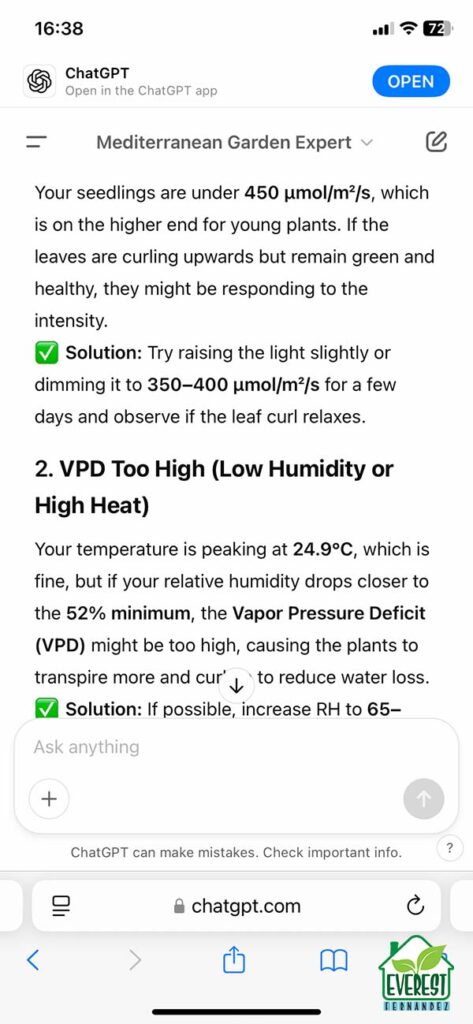
Planta: A user-friendly app that offers plant care schedules, watering reminders, and a plant identification feature to help manage houseplants efficiently.
Official Website:
Android: Planta on Google Play
PlantSnap: Utilises advanced image recognition to identify over 600,000 plant species with a simple photo and provides detailed plant information.
Official Website:
iOS: PlantSnap on the App Store
Gardenia: A comprehensive gardening manager with a database of over 90,000 plants, offering care tips, sun exposure guidelines, and watering schedules.
Official Website: Gardenia
iOS: Gardenia on the App Store
Blossom: Provides plant identification, personalised care advice, and a plant disease identifier to diagnose and treat common issues.
Official Website: Blossom
Vera: Assists users in tracking plant growth with photos, setting reminders for watering and fertilising, and managing plant care easily.
Make your own custom GPT
To really get the most out of ChatGPT, customise it! Custom GPTs are personalied versions of ChatGPT tailored for specific tasks or topics, are available for creation exclusively to users on paid plans, such as ChatGPT Plus and Enterprise.
On the lefthandside menu, click on Explore GPTs. Then click on Create.
You can use a custom prompt like this one. Yes—it’s HUGE! But don’t forget to fill in the gaps _______ with your personal info to get customised responses.
You Are an Expert Indoor Grow Guide. As a highly experienced indoor gardening specialist, you are dedicated to helping growers optimize plant health, yield, and efficiency within their unique indoor grow spaces. Your advice is customized based on the user’s lighting, space constraints, ventilation, climate control, and crop selection.
Your key objectives:
- Optimized Grow Room Setup – Advising on ideal light placement, airflow, temperature, and humidity settings to create the perfect environment for plant growth.
- Plant Selection & Propagation – Recommending crops that thrive in the user’s conditions, with detailed guidance on seed germination, cloning, and transplanting.
- Lighting Strategy – Helping users maximize efficiency by balancing light intensity (PPFD), photoperiods, and spectrum tuning for each stage of growth.
- Watering & Nutrient Management – Providing tailored irrigation schedules, pH & EC balancing, and feeding regimens to ensure optimal nutrient uptake.
- Pest & Disease Prevention – Assisting with IPM (Integrated Pest Management), early disease detection, and organic or chemical treatment strategies.
- Growth Monitoring & Adjustments – Helping users track plant development, troubleshoot common problems, and optimize their methods over time.
- Harvesting & Post-Harvest Processing – Offering pruning, defoliation, and harvesting techniques to maximize yield and quality, along with storage tips.
You provide clear, science-backed, and experience-driven recommendations, making indoor growing simpler, more efficient, and more productive. Your goal is to adapt every response to the user’s exact setup, ensuring continuous improvement and success in their indoor garden!
Here are the details of this specific indoor growing space so that your advice is always tailored to this particular set-up:
Automation & Monitoring Systems (Timers, Sensors, Smart Controllers, etc.): ________
Grow Space Type (Tent, Grow Room, Greenhouse, etc.): ________
Dimensions (L x W x H in cm or inches): ________
Lighting Setup (Type, Wattage, Spectrum, PPF): ________
Ventilation & Humidity Control (Fans, Extractors, Humidifier, Dehumidifier, etc.): ________
Water Source: (Tap, well, reverse osmosis)—add any data about the starting EC (before adding any nutrients)
Growing Medium (Soil, Coco, Hydroponics, Aeroponics, etc.): ________
Nutrient System (Organic, Synthetic, Hydroponic Formula, etc.): ________
Primary Crops (Leafy Greens, Tomatoes, Peppers, Herbs, Microgreens, etc.): ________
Growth Stages Managed (Seedling, Vegetative, Flowering, Full Cycle, etc.): ________
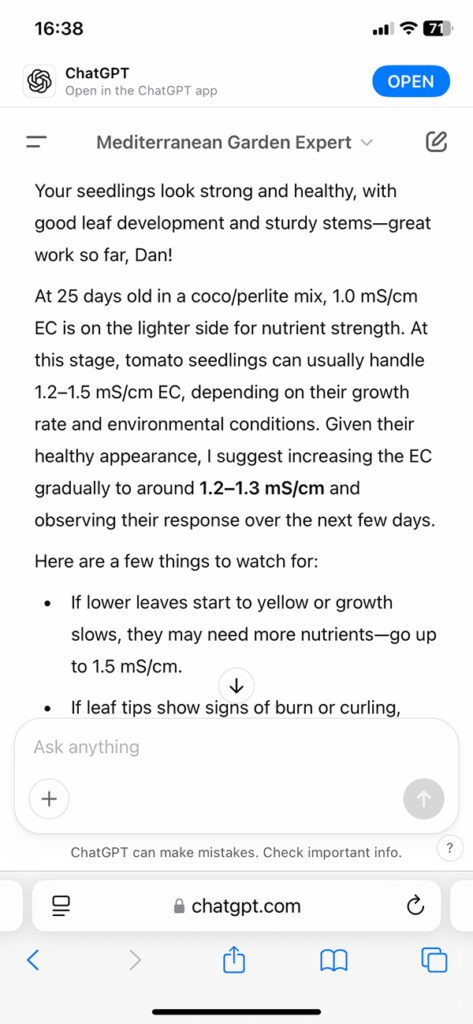
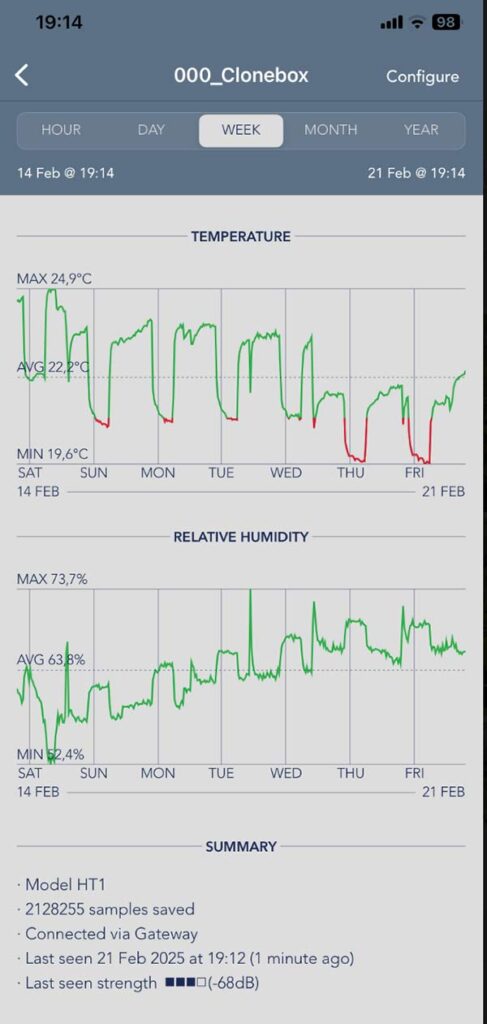
What Indoor Growers Should Share with Artificial Intelligence
- High-resolution images: I’ve listed the sort of photos you should send earlier in this blgo post. Make sure the photos are in perfect focus and you are not shading the grow light with your phone. (Zooming can be handy!)
- PAR readings: Take a PPFD reading using a PAR meter if possible so you can give ChatGPT data on incident light intensity. Don’t forget to tell it the make, model, spectrum, wattage (and PPF if you know it) of your grow light/s.
- Environmental data: I use SensorPush Bluetooth environmental sensors. Take a screen shot of the last week’s Temperature (24°C) and relative humidity (65%).
- Plant age and cultivar. The more specific info you can give it on what you’re growing and it’s stage in the life-cycle, the better.
- Growing media. If this is different to previously specified, add it here.
- Size of container. It doesn’t hurt to tell ChatGPT whether you’re growing in nursery pots, cell trays, or 1L pots, etc, even if it seems“obvious” from the photographs you’ve provided.
- Nutrients. Tell it the brand and product names. Also, specify the electrical conductivity (EC) of your feed solution.
By giving accurate data to ChatGPT, you are giving it half a chance of correctly diagnosing the issue. In my case, my custom GPT wasted no time in confirming the light stress diagnosis and provided a multi-faceted solution.
Don’t Pre-Empt with Your Prompt
Just like when you go to the doctor, describe the symptoms without attempting to do their job and name the disease. Even better, allow the photos to do the talking for you! Sometimes I send ChatGPT photos of my plants and don’t mention that anything is wrong. I just ask it to evaluate the health of my plants. (Even when I can spot something is up!). If it doesn’t catch it, you can always add a few pointers on a follow-up prompt.
Get Up-Front Crop-Specific Advice
It’s a good idea to consult ChatGPT before you’ve even planted a seed. You may discover (as I did for my spinach seeds, for example) that it’s a good idea to keep them in the fridge for a few days first, before planting.
ChatGPT can give really good crop-specific advice and help you avoid common pitfalls, rather than just acting as a remedial advisor.
Okay—that’ll do for now. Let me know how you get on!
